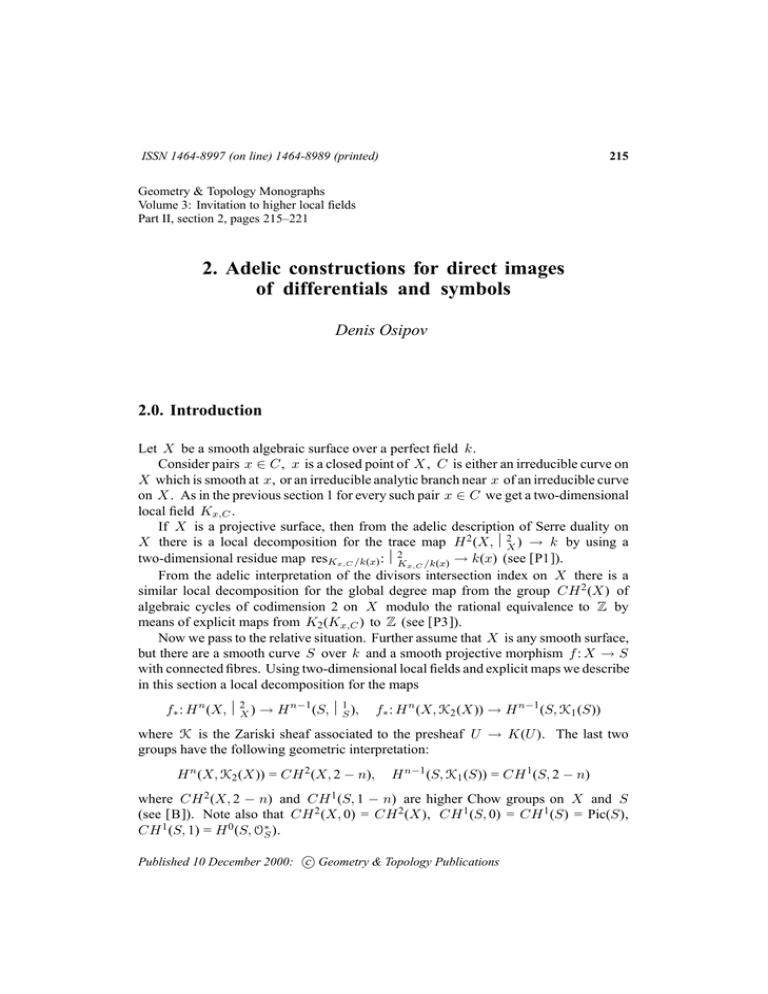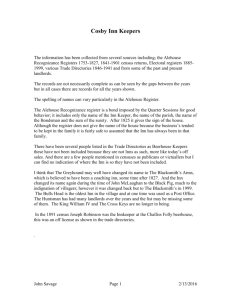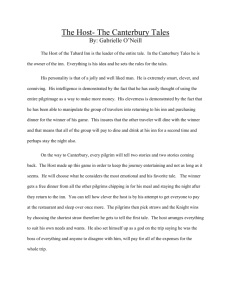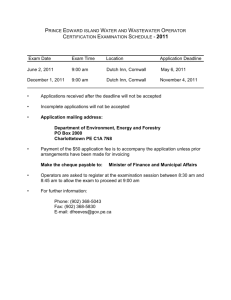Geometry & Topology Monographs Volume 3: Invitation to higher local fields
advertisement

ISSN 1464-8997 (on line) 1464-8989 (printed)
215
Geometry & Topology Monographs
Volume 3: Invitation to higher local fields
Part II, section 2, pages 215–221
2. Adelic constructions for direct images
of differentials and symbols
Denis Osipov
2.0. Introduction
Let X be a smooth algebraic surface over a perfect field k .
Consider pairs x ∈ C , x is a closed point of X , C is either an irreducible curve on
X which is smooth at x , or an irreducible analytic branch near x of an irreducible curve
on X . As in the previous section 1 for every such pair x ∈ C we get a two-dimensional
local field Kx,C .
If X is a projective surface, then from the adelic description of Serre duality on
X there is a local decomposition for the trace map H 2 (X, Ω2X ) → k by using a
two-dimensional residue map resKx,C /k(x) : Ω2Kx,C /k(x) → k(x) (see [ P1 ]).
From the adelic interpretation of the divisors intersection index on X there is a
similar local decomposition for the global degree map from the group CH 2 (X) of
algebraic cycles of codimension 2 on X modulo the rational equivalence to Z by
means of explicit maps from K2 (Kx,C ) to Z (see [ P3 ]).
Now we pass to the relative situation. Further assume that X is any smooth surface,
but there are a smooth curve S over k and a smooth projective morphism f : X → S
with connected fibres. Using two-dimensional local fields and explicit maps we describe
in this section a local decomposition for the maps
f∗ : H n (X, Ω2X ) → H n−1 (S, Ω1S ),
f∗ : H n (X, K2 (X)) → H n−1 (S, K1 (S))
where K is the Zariski sheaf associated to the presheaf U → K(U ). The last two
groups have the following geometric interpretation:
H n (X, K2 (X)) = CH 2 (X, 2 − n),
H n−1 (S, K1 (S)) = CH 1 (S, 2 − n)
where CH 2 (X, 2 − n) and CH 1 (S, 1 − n) are higher Chow groups on X and S
(see [ B ]). Note also that CH 2 (X, 0) = CH 2 (X), CH 1 (S, 0) = CH 1 (S) = Pic(S),
CH 1 (S, 1) = H 0 (S, O∗S ).
c Geometry & Topology Publications
Published 10 December 2000: 216
D. Osipov
Let s = f (x) ∈ S . There is a canonical embedding f ∗ : Ks → Kx,C where Ks is
the quotient of the completion of the local ring of S at s .
Consider two cases:
(1) C 6= f −1 (s). Then Kx,C is non-canonically isomorphic to k(C)x ((tC )) where
k(C)x is the completion of k(C) at x and tC is a local equation of C near x .
(2) C = f −1 (s). Then Kx,C is non-canonically isomorphic to k(x)((u))((ts )) where
{u = 0} is a transversal curve at x to f −1 (s) and ts ∈ Ks is a local parameter at
s , i.e. k(s)((ts )) = Ks .
2.1. Local constructions for differentials
Definition. For K = k((u))((t)) let U = ui k[[u, t]]dk[[u, t]]+tj k((u))[[t]]dk((u))[[t]]
be a basis of neighbourhoods of zero in Ω1k((u))[[t]]/k (compare with 1.4.1 of Part I). Let
e 1 = Ω1 /(K · ∩U ) and Ω
e n = ∧n Ω
e 1 . Similarly define Ω
en .
Ω
K
K
K/k
Ks
K
e2
en
Note that Ω
Kx,C is a one-dimensional space over Kx,C ; and ΩKx,C does not
b x , where O
b x is the completion
depend on the choice of a system of local parameters of O
of the local ring of X at x .
Definition. For K = k((u))((t)) and ω =
put
P
i ωi (u)
∧ ti dt =
P
i
i u du
e2
∧ ωi0 (t) ∈ Ω
K
e1
rest (ω) = ω−1 (u) ∈ Ω
k ((u)) ,
0
e1
resu (ω) = ω−
1 (t) ∈ Ωk ((t)) .
Define a relative residue map
e2
e1
f∗x,C : Ω
Kx,C → ΩKs
as
f∗x,C (ω)
=
Tr k(C )x /Ks restC (ω)
if C 6= f −1 (s)
Tr k(x)((ts ))/Ks resu (ω)
if C = f −1 (s).
The relative residue map doesn’t depend on the choice of local parameters.
e 2 where Kx
Theorem (reciprocity laws for relative residues). Fix x ∈ X . Let ω ∈ Ω
Kx
b x . Then
is the minimal subring of Kx,C which contains k(X) and O
X
f∗x,C (ω) = 0.
C3x
Geometry & Topology Monographs, Volume 3 (2000) – Invitation to higher local fields
Part II. Section 2. Adelic constructions for direct images
217
e 2 where KF is the completion of k(X) with respect to the
Fix s ∈ S . Let ω ∈ Ω
KF
discrete valuation associated with the curve F = f −1 (s). Then
X
f∗x,F (ω) = 0.
x∈F
See [ O ].
2.2. The Gysin map for differentials
Definition. In the notations of subsection 1.2.1 in the previous section put
Y
e 1 , vs (fs ) > 0 for almost all s ∈ S }
Ω1AS = {(fs dts ) ∈
Ω
Ks
s∈S
where ts is a local parameter at s , vs is the discrete valuation associated to ts and
Ks is the quotient of the completion of the local ring of S at s . For a divisor I on S
define
ΩAS (I) = {(fs ) ∈ Ω1AS : vs (fs ) > −vs (I)
for all s ∈ S }.
Recall that the n -th cohomology group of the following complex
Ω1k(S )/k ⊕ Ω1AS (0)
(f0 , f1 )
Ω1AS
f0 + f1 .
−→
7−→
is canonically isomorphic to H n (S, Ω1S ) (see [ S, Ch.II ]).
The sheaf Ω2X is invertible on X . Therefore, Parshin’s theorem (see [ P1 ]) shows
that similarly to the previous definition and definition in 1.2.2 of the previous section
for the complex Ω2 (AX )
Ω2A0 ⊕ Ω2A1 ⊕ Ω2A2
(f0 , f1 , f2 )
−→
7−→
Ω2A01 ⊕ Ω2A02 ⊕ Ω2A12
(f0 + f1 , f2 − f0 , −f1 − f2 )
(g1 , g2 , g3 )
where
Ω2Ai ⊂ Ω2Aij ⊂ Ω2A012 = Ω2AX =
Y0
e2
Ω
Kx,C ⊂
x∈C
−→
Ω2A012
7−→
g1 + g2 + g3
Y
e2
Ω
Kx,C
x∈C
there is a canonical isomorphism
H n (Ω2 (AX )) ' H n (X, Ω2X ).
Using the reciprocity laws above one can deduce:
Geometry & Topology Monographs, Volume 3 (2000) – Invitation to higher local fields
218
D. Osipov
P
x,C
Theorem. The map f∗ =
from Ω2AX to Ω1AS is well defined. It
C3x,f (x)=s f∗
maps the complex Ω2 (AX ) to the complex
0 −→ Ω1k(S )/k ⊕ Ω1AS (0) −→ Ω1AS .
It induces the map f∗ : H n (X, Ω2X ) → H n−1 (S, Ω1S ) of 2.0.
See [ O ].
2.3. Local constructions for symbols
Assume that k is of characteristic 0.
Theorem. There is an explicitly defined symbolic map
∗
∗
f∗ ( , )x,C : Kx,C
× Kx,C
→ Ks∗
(see remark below ) which is uniquely determined by the following properties
Nk(x)/k(s) tKx,C (α, β, f ∗ γ) = tKs (f∗ (α, β)x,C , γ)
∗
for all α, β ∈ Kx,C
, γ ∈ Ks∗
where tKx,C is the tame symbol of the two-dimensional local field Kx,C and tKs is
the tame symbol of the one-dimensional local field Ks (see 6.4.2 of Part I);
Tr k(x)/k(s) (α, β, f ∗ (γ)]Kx,C = (f∗ (α, β)x,C , γ]Ks
∗
for all α, β ∈ Kx,C
, γ ∈ Ks
where (α, β, γ]Kx,C = resKx,C /k(x) (γdα/α ∧ dβ/β) and
(α, β]Ks = resKs /k(s) (αdβ/β).
The map f∗ ( , )x,C induces the map
f∗ ( , )x,C : K2 (Kx,C ) → K1 (Ks ).
Corollary (reciprocity laws). Fix a point s ∈ S . Let F = f −1 (s).
Let α, β ∈ KF∗ . Then
Y
f∗ (α, β)x,F = 1.
x∈F
Fix a point x ∈ F . Let α, β ∈ Kx∗ . Then
Y
f∗ (α, β)x,C = 1.
C3x
−1
Remark. If C 6= f (s) then f∗ ( , )x,C = Nk(C )x /Ks tKx,C where tKx,C is the tame
symbol with respect to the discrete valuation of rank 1 on Kx,C .
1
coincides with
If C = f −1 (s) then f∗ ( , )x,C = Nk(x)((ts ))/Ks ( , )f where ( , )−
f
Kato’s residue homomorphism [ K, §1 ]. An explicit formula for ( , )f is constructed in
[ O, Th.2 ].
Geometry & Topology Monographs, Volume 3 (2000) – Invitation to higher local fields
Part II. Section 2. Adelic constructions for direct images
219
2.4. The Gysin map for Chow groups
Assume that k is of arbitrary characteristic.
Definition. Let K20 (AX ) be the subset of all (fx,C ) ∈ K2 (Kx,C ), x ∈ C such that
(a) fx,C ∈ K2 (Ox,C ) for almost all irreducible curves C where Ox,C is the ring of
integers of Kx,C with respect to the discrete valuation of rank 1 on it;
(b) for all irreducible curves C ⊂ X , all integers r > 1 and almost all points x ∈ C
b x [t−1 ]) ⊂ K2 (Kx,C )
fx,C ∈ K2 (Ox,C , MrC ) + K2 (O
C
where MC is the maximal ideal of Ox,C and
K2 (A, J ) = ker(K2 (A) → K2 (A/J )).
This definition is similar to the definition of [ P2 ].
Definition. Using the diagonal map of K2 (KC ) to
Q
to
K2 (Kx∈C ) put
C3x
K20 (A01 ) = K20 (AX ) ∩ image of
Q
K2 (Kx∈C ) and of K2 (Kx )
x∈C
Y
K2 (KC ),
C⊂X
K20 (A02 ) = K20 (AX ) ∩ image of
Y
K2 (Kx ),
x∈X
K20 (A12 ) = K20 (AX ) ∩ image of
Y
K2 (Ox,C ),
x∈C
K20 (A0 ) = K2 (k(X)),
K20 (A1 ) = K20 (AX ) ∩ image of
Y
K2 (OC ),
C⊂X
0
0
K2 (A2 ) = K2 (AX ) ∩ image of
Y
b x)
K2 (O
x∈X
where OC is the ring of integers of KC .
Define the complex K2 (AX ):
K20 (A0 ) ⊕ K20 (A1 ) ⊕ K20 (A2 ) →K20 (A01 ) ⊕ K20 (A02 ) ⊕ K20 (A12 ) → K20 (A012 )
(f0 , f1 , f2 ) 7→(f0 + f1 , f2 − f0 , −f1 − f2 )
(g1 , g2 , g3 )
7→
g1 + g2 + g3
where K20 (A012 ) = K20 (AX ).
Using the Gersten resolution from K -theory (see [ Q, §7 ]) one can deduce:
Geometry & Topology Monographs, Volume 3 (2000) – Invitation to higher local fields
220
D. Osipov
Theorem. There is a canonical isomorphism
H n (K2 (AX )) ' H n (X, K2 (X)).
Similarly one defines K10 (AS ). From H 1 (S, K1 (S)) = H 1 (S, O∗S ) = Pic(S) (or
from the approximation theorem) it is easy to see that the n -th cohomology group of
the following complex
P
b s ) −→ K 0 (AS )
K1 (k(S)) ⊕ s∈S K1 (O
1
(f0 , f1 )
7−→ f0 + f1 .
b s is the completion of the local
is canonically isomorphic to H n (S, K1 (S)) (here O
ring of C at s ).
Assume that k is of characteristic 0.
Using the reciprocity law above and the previous theorem one can deduce:
P
Theorem. The map f∗ = C3x,f (x)=s f∗ ( , )x,C from K20 (AX ) to K10 (AS ) is well
defined. It maps the complex K2 (AX ) to the complex
X
b s ) −→ K 0 (AS ).
0 −→ K1 (k(S)) ⊕
K1 (O
1
s∈S
It induces the map f∗ : H n (X, K2 (X)) → H n−1 (S, K1 (S)) of 2.0.
If n = 2 , then the last map is the direct image morphism (Gysin map) from CH 2 (X)
to CH 1 (S).
References
[B]
[K]
[O]
[P1]
S. Bloch, Algebraic K-theory, motives and algebraic cycles, ICM90, p.43–54.
K. Kato, Residue homomorphism in Milnor K-theory, Galois groups and their representations (Nagoya 1981), Advanced Studies in Pure Math., vol. 2, North-Holland,
Amsterdam-New York 1983, p.153–172.
D. V. Osipov, Adele constructions of direct images of differentials and symbols, Mat.
Sbornik (1997); English translation in Sbornik: Mathematics 188:5 (1997), 697–723;
slightly revised version in e-print alg-geom/9802112.
A. N. Parshin On the arithmetic of two-dimensional schemes. I. Repartitions and residues,
Izv. Akad. Nauk SSSR Ser. Mat. 40(4) (1976), p.736–773; English translation in Math.
USSR Izv. 10 (1976).
Geometry & Topology Monographs, Volume 3 (2000) – Invitation to higher local fields
Part II. Section 2. Adelic constructions for direct images
[P2]
[P3]
[Q]
[S]
221
A. N. Parshin, Abelian coverings of arithmetical schemes, DAN USSR, v.243 (1978),
p.855–858; English translation in Soviet. Math. Doklady 19 (1978).
A. N. Parshin, Chern classes, adeles and L -functions, J. reine angew. Math. 341(1983),
174–192.
D. Quillen, Higher algebraic K-theory 1, Lecture Notes Math. 341, Algebraic K-theory
I, Springer-Verlag, Berlin etc., 85–147.
J.-P. Serre, Groupes algébriques et corps de classes, Hermann, Paris, 1959.
Department of Algebra, Steklov Mathematical Institute, Ul. Gubkina, 8, Moscow, GSP-1,
117966, Russia
Email: d− osipov@ mail.ru
Geometry & Topology Monographs, Volume 3 (2000) – Invitation to higher local fields


